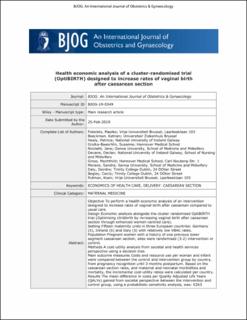Please use this identifier to cite or link to this item:
https://doi.org/10.21256/zhaw-3265| Publication type: | Article in scientific journal |
| Type of review: | Peer review (publication) |
| Title: | Health economic analysis of a cluster‐randomised trial (OptiBIRTH) designed to increase rates of vaginal birth after caesarean section |
| Authors: | Fobelets, Maaike Beeckman, Katrien Healy, Patricia Grylka, Susanne Nicoletti, Jane Devane, Declan Gross, Mechthild Maria Morano, Sandra Daly, Deirdre Begley, Cecily Putman, Koen |
| DOI: | 10.21256/zhaw-3265 10.1111/1471-0528.15673 |
| Published in: | BJOG - International Journal of Obstetrics and Gynaecology |
| Issue Date: | 2019 |
| Publisher / Ed. Institution: | Wiley |
| ISSN: | 1470-0328 1471-0528 |
| Language: | English |
| Subjects: | Cost-effectiveness analysis; Elective repeat caesarean; Quality of life; Vaginal birth after caesarean |
| Subject (DDC): | 362.1041: Health economics 618.4: Childbirth |
| Abstract: | Objective: To perform a health economic analysis of an intervention designed to increase rates of vaginal birth after caesarean, compared with usual care. Design: Economic analysis alongside the cluster-randomised OptiBIRTH trial (Optimising childbirth by increasing vaginal birth after caesarean section (VBAC) through enhanced women-centred care). Setting: Fifteen maternity units in three European countries - Germany (five), Ireland (five), and Italy (five) - with relatively low VBAC rates. Population: Pregnant women with a history of one previous lower-segment caesarean section; sites were randomised (3:2) to intervention or control. Methods: A cost-utility analysis from both societal and health-services perspectives, using a decision tree. Main Outcome Measures: Costs and resource use per woman and infant were compared between the control and intervention group by country, from pregnancy recognition until 3 months postpartum. Based on the caesarean section rates, and maternal and neonatal morbidities and mortality, the incremental cost-utility ratios were calculated per country. Results: The mean difference in costs per quality-adjusted life years (QALYs) gained from a societal perspective between the intervention and the control group, using a probabilistic sensitivity analysis, was: €263 (95% CI €258-268) and 0.008 QALYs (95% CI 0.008-0.009 QALYs) for Germany, €456 (95% CI €448-464) and 0.052 QALYs (95% CI 0.051-0.053 QALYs) for Ireland, and €1174 (95% CI €1170-1178) and 0.006 QALYs (95% CI 0.005-0.007 QALYs) for Italy. The incremental cost-utility ratios were €33,741/QALY for Germany, €8785/QALY for Ireland, and €214,318/QALY for Italy, with a 51% probability of being cost-effective for Germany, 92% for Ireland, and 15% for Italy. Conclusion: The OptiBIRTH intervention was likely to be cost-effective in Ireland and Germany. |
| Further description: | Der Artikel wurde innerhalb des EU-Projekts OptiBIRTH erstellt. This is the peer reviewed version of the following article: [Haunberger, S, Rüegger, C, Baumgartner, E. Experiences with a psychosocial screening instrument (S‐FIRST) to identify the psychosocial support needs of parents of children suffering from cancer. Psycho‐Oncology. 2019; 28: 1025‐ 1032.], which has been published in final form at https://doi.org/10.1002/pon.5045. This article may be used for non-commercial purposes in accordance with Wiley Terms and Conditions for Use of Self-Archived Versions. |
| URI: | https://digitalcollection.zhaw.ch/handle/11475/17132 |
| Fulltext version: | Accepted version |
| License (according to publishing contract): | Licence according to publishing contract |
| Restricted until: | 2020-05-01 |
| Departement: | School of Health Sciences |
| Organisational Unit: | Institute of Midwifery and Reproductive Health (IHG) |
| Appears in collections: | Publikationen Gesundheit |
Files in This Item:
| File | Description | Size | Format | |
|---|---|---|---|---|
| bjog-19-0349.pdf | Accepted Version | 567.94 kB | Adobe PDF |  View/Open |
Show full item record
Fobelets, M., Beeckman, K., Healy, P., Grylka, S., Nicoletti, J., Devane, D., Gross, M. M., Morano, S., Daly, D., Begley, C., & Putman, K. (2019). Health economic analysis of a cluster‐randomised trial (OptiBIRTH) designed to increase rates of vaginal birth after caesarean section. BJOG - International Journal of Obstetrics and Gynaecology. https://doi.org/10.21256/zhaw-3265
Fobelets, M. et al. (2019) ‘Health economic analysis of a cluster‐randomised trial (OptiBIRTH) designed to increase rates of vaginal birth after caesarean section’, BJOG - International Journal of Obstetrics and Gynaecology [Preprint]. Available at: https://doi.org/10.21256/zhaw-3265.
M. Fobelets et al., “Health economic analysis of a cluster‐randomised trial (OptiBIRTH) designed to increase rates of vaginal birth after caesarean section,” BJOG - International Journal of Obstetrics and Gynaecology, 2019, doi: 10.21256/zhaw-3265.
FOBELETS, Maaike, Katrien BEECKMAN, Patricia HEALY, Susanne GRYLKA, Jane NICOLETTI, Declan DEVANE, Mechthild Maria GROSS, Sandra MORANO, Deirdre DALY, Cecily BEGLEY und Koen PUTMAN, 2019. Health economic analysis of a cluster‐randomised trial (OptiBIRTH) designed to increase rates of vaginal birth after caesarean section. BJOG - International Journal of Obstetrics and Gynaecology. 2019. DOI 10.21256/zhaw-3265
Fobelets, Maaike, Katrien Beeckman, Patricia Healy, Susanne Grylka, Jane Nicoletti, Declan Devane, Mechthild Maria Gross, et al. 2019. “Health Economic Analysis of a Cluster‐Randomised Trial (OptiBIRTH) Designed to Increase Rates of Vaginal Birth after Caesarean Section.” BJOG - International Journal of Obstetrics and Gynaecology. https://doi.org/10.21256/zhaw-3265.
Fobelets, Maaike, et al. “Health Economic Analysis of a Cluster‐Randomised Trial (OptiBIRTH) Designed to Increase Rates of Vaginal Birth after Caesarean Section.” BJOG - International Journal of Obstetrics and Gynaecology, 2019, https://doi.org/10.21256/zhaw-3265.
Items in DSpace are protected by copyright, with all rights reserved, unless otherwise indicated.